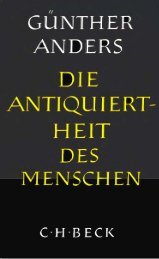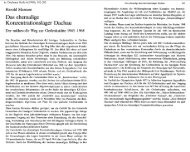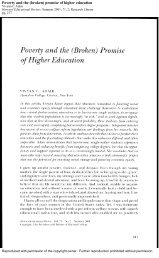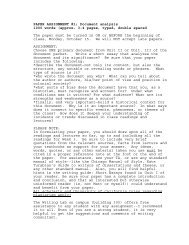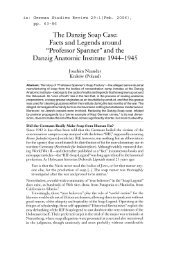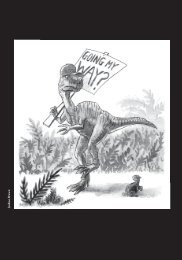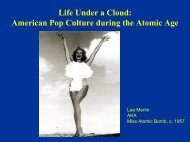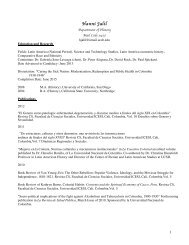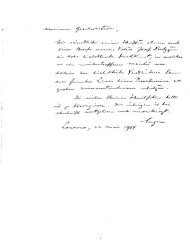Museums in Motion, chapter 1 - UCSB Department of History
Museums in Motion, chapter 1 - UCSB Department of History
Museums in Motion, chapter 1 - UCSB Department of History
Create successful ePaper yourself
Turn your PDF publications into a flip-book with our unique Google optimized e-Paper software.
Ir<br />
I<br />
Charles Willson Peale, the artist, <strong>in</strong> his Philadelphia museum; 1822<br />
£ Jw c.rJIt (.e 'f.c,.~ M~·d~'-1.'-'\!; 1\ M <strong>of</strong>f M:<br />
- {tv. L¥vJ ...cn.M io tk- Ki>~7 -{-~~~ <strong>of</strong><br />
/l""I~~> (v-J e.l ~"';Il~~: A'I/}\U,{/ l Dt:r,~~-{('<br />
~""'"' m the United Sta"" are growmg at an almost frighten<strong>in</strong>g<br />
rate. Ifwe count the smallest ones with only one person on the staff and<br />
he or she without pr<strong>of</strong>essional tra<strong>in</strong><strong>in</strong>g, about five thousand <strong>of</strong> them<br />
exist today, and recently a new one has appeared every 3.3 days. People<br />
are crowd<strong>in</strong>g <strong>in</strong>to them <strong>in</strong> droves, and the annual visits made to<br />
museums are now estimated at 600 million, give or take 100 million.!<br />
Museum Def<strong>in</strong>itions: Friendly and Unfriendly<br />
A museum is a complex <strong>in</strong>stitution, and def<strong>in</strong><strong>in</strong>g it is not easy.<br />
Whether one likes or dislikes museums will <strong>in</strong>fluence one's def<strong>in</strong>ition.<br />
Douglas Allan, late director <strong>of</strong> the Royal Scottish Museum <strong>in</strong> Ed<strong>in</strong>burgh,<br />
said that "a museum <strong>in</strong> its simplest form consists <strong>of</strong> a build<strong>in</strong>g to house<br />
collections <strong>of</strong> objects for <strong>in</strong>spection, study and enjoyment. "2 Except for<br />
the conf<strong>in</strong><strong>in</strong>g <strong>of</strong> the museum to a s<strong>in</strong>gle build<strong>in</strong>g, perhaps most <strong>of</strong> us<br />
would agree with that generalization.<br />
The American Association <strong>of</strong> <strong>Museums</strong>, <strong>in</strong> develop<strong>in</strong>g a nationwide<br />
museum accreditation program, has def<strong>in</strong>ed a museum as "an organized<br />
and permanent non-pr<strong>of</strong>it <strong>in</strong>stitution, essentially educational or aesthetic<br />
<strong>in</strong> purpose, with pr<strong>of</strong>essional staff, which owns and utilizes tangible<br />
objects, cares for them, and exhibits them to the public on some regular<br />
schedule."3 That def<strong>in</strong>ition has met some objection from art centers,<br />
neighborhood museums, science centers, and planetariums that have<br />
li!tle or no collection, and.the association is beg<strong>in</strong>n<strong>in</strong>g to develop special<br />
def<strong>in</strong>itions for some <strong>of</strong> these categories. Those who emphasize the<br />
research function <strong>of</strong> the museum would like to see research mentioned <strong>in</strong><br />
the def<strong>in</strong>ition.<br />
Thomas P. V. Hov<strong>in</strong>g, former director <strong>of</strong> the Metropolitan Museum <strong>of</strong><br />
Art, declares that the museum possesses "a great potential, not only as a<br />
stabiliz<strong>in</strong>g, regenerative force <strong>in</strong> modern society, but as a crusad<strong>in</strong>g<br />
force for quality and excellence."4 Dillon Ripley, secretary <strong>of</strong> the Smithsonian<br />
Institution, which operates the huge national museum<br />
megalopolis <strong>in</strong> Wash<strong>in</strong>gton, th<strong>in</strong>ks that "a museum can be a powerhouse<br />
," though only if "museum people and the public get away from<br />
the 'attic' mentality."s<br />
A lively German writer describes an art museum as a place "where<br />
every separate object kills every other and all <strong>of</strong> them together the<br />
5
6 MUSEUMS IN MOTION WHAT IS A MUSEUM? 7<br />
visitor," and some critics would do away with museums altogether.<br />
Filippo Tommaso Mar<strong>in</strong>etti, a founder <strong>of</strong> Italian Futurism, <strong>in</strong> 1908urged<br />
artists to start afresh and ignore all tradition. He wished to destroy<br />
museums (and libraries also) and welcomed "the k<strong>in</strong>dly <strong>in</strong>cendiaries<br />
with the carbon f<strong>in</strong>gers!" He went on to say:<br />
<strong>Museums</strong>, cemeteries! .. : Identical truly <strong>in</strong> the s<strong>in</strong>ister promiscuousness <strong>of</strong> so<br />
many objects unknown to each other. Public dormitories, where one is forever<br />
slumber<strong>in</strong>g beside hated and unknown be<strong>in</strong>gs. Reciprocal ferocity <strong>of</strong> pa<strong>in</strong>ters<br />
and sculptors murder<strong>in</strong>g each other with blows <strong>of</strong> form and color <strong>in</strong> the same<br />
museum.6<br />
Today, unless museums reform themselves, some militant m<strong>in</strong>ority<br />
groups also advocate their destruction. June Jordan, a black poet, not<br />
long ago electrified a museum sem<strong>in</strong>ar <strong>in</strong> Brooklyn when she said:<br />
Take me <strong>in</strong>to the museum and show me myself, show me my people, show me<br />
soul America. If you cannot show me myself, if you cannot teach my people what<br />
they need to know-and they need to know the truth, and they need to know that<br />
noth<strong>in</strong>g is more important than human life-if you cannot show arid teach these<br />
th<strong>in</strong>gs, then why shouldn't I attack the temples <strong>of</strong> America and blow them up?<br />
The people who hold the power, and the people who count pennies, and the<br />
people who hold the keys better start th<strong>in</strong>k<strong>in</strong>g it all over aga<strong>in</strong>.7<br />
Perhaps this is attempt enough at def<strong>in</strong>ition,for the moment, and we<br />
should leave the subject while enjoy<strong>in</strong>g the quip <strong>of</strong> an anonymous<br />
Englishman who considers the museum" a depository <strong>of</strong> curiosities that<br />
more <strong>of</strong>ten than not <strong>in</strong>cludes the director."<br />
Ancient and Medieval Prototypes<br />
The Lat<strong>in</strong> word museum (Greek: mouseion) has had a variety <strong>of</strong><br />
mean<strong>in</strong>gs through the centuries. In classical times it signified a temple<br />
dedicated to the Muses, those n<strong>in</strong>e sprightly and pieasantly amoral<br />
young goddesses who watched over the welfare <strong>of</strong> the epic, music, love<br />
poetry, oratory, history, tragedy, comedy, the dance, and astronomy.<br />
The most famous museum <strong>of</strong> that era was founded at Alexandria about<br />
the third century B.C. by Ptolemy Soter ("Preserver") and was destroyed<br />
dur<strong>in</strong>g various civil disturbances <strong>in</strong> the third century A.D. The Mouseion<br />
<strong>of</strong> Alexandria had some objects, <strong>in</strong>clud<strong>in</strong>g statues <strong>of</strong> th<strong>in</strong>kers, astronomical<br />
and surgical <strong>in</strong>struments, elephant trunks and animal hides, and a<br />
botanical and zoological park, but it was chiefly a university or<br />
philosophical academy-a k<strong>in</strong>d <strong>of</strong> <strong>in</strong>stitute <strong>of</strong> advanced study with<br />
many prom<strong>in</strong>ent scholars <strong>in</strong> residence and supported by the state. The<br />
museum and the great <strong>in</strong>ternational library <strong>of</strong> papyrus rolls and other<br />
writ<strong>in</strong>gs collected by Alexander the Great were housed <strong>in</strong> the royal<br />
quarter <strong>of</strong> the city known as the Bruchium. Euclid headed the mathematics<br />
faculty and wrote his Elements <strong>of</strong> Geometry there. Archimedes,<br />
Appolonius <strong>of</strong> Perga, and Eratosthenes were only a few <strong>of</strong> the noted<br />
scientists and scholars who lived <strong>in</strong> the k<strong>in</strong>g's household and made use<br />
<strong>of</strong> library, lecture halls, covered walks, refectory, laboratories for dissection<br />
and scientific studies, and botanical and 'zoological'gardens. 8 Some<br />
modern students <strong>of</strong> the museum movement, who emphasize its research<br />
function and prefer to def<strong>in</strong>e the museum as a community <strong>of</strong> scholars,<br />
look back on the Alexandria <strong>in</strong>stitution with real affection and nostalgia.<br />
Though the Gteeks and Romans thought <strong>of</strong> the museum <strong>in</strong> different<br />
terms from those we use today, the ancient world did possess public<br />
collections <strong>of</strong> objects valued for their aesthetic, historic, religious, or<br />
magical importance. The Greek temples had hoards <strong>of</strong> votive <strong>of</strong>fer<strong>in</strong>gs <strong>of</strong><br />
gold, silver, and, bronze objects, statues and statuettes, pa<strong>in</strong>t<strong>in</strong>gs, and<br />
even bullion that could be expended <strong>in</strong> case <strong>of</strong> public emergency. The<br />
pa<strong>in</strong>t<strong>in</strong>gs were on planks (Greek: p<strong>in</strong>as), and thus a collection <strong>of</strong> them<br />
was called p<strong>in</strong>akotheke. In the fifth century the Acropolis at Athens had<br />
such pa<strong>in</strong>t<strong>in</strong>gs <strong>in</strong> the Prophylae, placed above a marble dado, lighted by<br />
two w<strong>in</strong>dows from the south, and protected <strong>in</strong>dividually by shutters.<br />
The Romans displayed pa<strong>in</strong>t<strong>in</strong>gs and sculpture, <strong>of</strong>ten the booty <strong>of</strong> their<br />
conquests, <strong>in</strong> fOiIUms,public gardens, temples, theaters, and baths.<br />
Roman generals, statesmen, and wealthy patricians <strong>of</strong>ten appropriated<br />
such objects for their country homes. The emperor Hadrian <strong>in</strong> the second<br />
century at his villa near Tibur (today Tivoli) reconstructed some <strong>of</strong> the<br />
landmarks he had seen <strong>in</strong> his travels through the empire, for example,<br />
the Lyceum and Academy <strong>of</strong> Athens, the Vale <strong>of</strong> Temple-<strong>in</strong> Thessaly, and<br />
the Canopus <strong>of</strong> the Egyptian delta. In a sense he created an open-air or<br />
outdoor museum.9<br />
The museum idea was barely kept alive <strong>in</strong> western Europe dur<strong>in</strong>g the<br />
Middle Ages. Churches, cathedrals, and monasteries venerated alleged<br />
relics <strong>of</strong> the Virg<strong>in</strong>, Christ, the apostles, and the sa<strong>in</strong>ts and embellished<br />
them with gold, silver, and jewels, manuscripts <strong>in</strong> sumptuous metal<br />
b<strong>in</strong>d<strong>in</strong>gs, and rich oriental fabrics. The Crusades brought back fabulous<br />
art 0bjects to add to these treasuries or to the palace collections <strong>of</strong> pr<strong>in</strong>ces<br />
and nobles, thus illustrat<strong>in</strong>g what the late Francis Taylor wittily called<br />
the "magpiety" <strong>of</strong> mank<strong>in</strong>d.tO In Islam, Ch<strong>in</strong>a, and Japan similar<br />
accumulations were made, and the Shoso-<strong>in</strong> (eighth century) at Todaiji<br />
Monastery at Nata near Kyoto is probably the oldest museum <strong>in</strong> the<br />
world. 11
8 MUSEUMS IN MOTION WHAT IS A MUSEUM? 9<br />
From Private Collection to Public Museum<br />
Museum<br />
Functions<br />
"The modem museum," says J. Mordaunt Crook, <strong>in</strong> his architectural<br />
study <strong>of</strong> the British Museum, "is a product <strong>of</strong> Renaissance humanism,<br />
eighteenth-century enlightenment and n<strong>in</strong>eteenth-century democracy."<br />
The humanist, with keen <strong>in</strong>terest <strong>in</strong> the classical past and the world<br />
about him, began to throw <strong>of</strong>f the re<strong>in</strong>s <strong>of</strong> superstition and take halt<strong>in</strong>g<br />
steps toward a scientific method. Two new words appeared <strong>in</strong> the<br />
sixteenth century to express the museum concept. The gallery (Italian:<br />
galleria), a long grand hall lighted from the side, came to signify an<br />
exhibition area for pictures and sculpture. The cab<strong>in</strong>et (Italian: gab<strong>in</strong>etto)<br />
was usually a square-shaped room filled with stuffed animals, botanical<br />
rarities, small works <strong>of</strong> art such as medallions or statuettes, artifacts, and<br />
curios; the Germans called it Wunderkammer. Both types <strong>of</strong> collections<br />
rarely were open to the public and rema<strong>in</strong>ed the playth<strong>in</strong>gs <strong>of</strong> pr<strong>in</strong>ces,<br />
popes, and plutocrats. 12<br />
The ancient world had had its great gardens, and medieval monasteries<br />
cultivated and cherished plants and flowers, but true botanical<br />
gardens now began to appear at the universities-Pisa (1543), Padua<br />
(1545),Bologna (1567),Leiden (1587),Heidelberg and Montpellier (1593),<br />
and Oxford (1620). Scholarly botanists used them for scientific plant<br />
study; physicians, for test<strong>in</strong>g remedies. Herbalists, barber surgeons,<br />
apothecaries, and physicians also established physic gardens as sources<br />
for medic<strong>in</strong>al materials, for example, at Holburn and Chelsea <strong>in</strong> London.13<br />
The museum began to go public <strong>in</strong> the late seventeenth century. Basel<br />
opened the first university· museum <strong>in</strong> 1671, and the Ashmolean<br />
Museum appeared at Oxford a dozen years later. The eighteenth century<br />
concerned itself with discover<strong>in</strong>g the basic natural laws that formed a<br />
framework for the universe and humanity, and <strong>in</strong>tellectuals <strong>of</strong> the day<br />
wished to preserve <strong>in</strong> museums natural specimens as well as human<br />
artistic and scientific creations. Supposedly they would help educate<br />
humank<strong>in</strong>d and abet its steady progress toward perfection. The Vatican<br />
established several museums about 1750, and the British Museum was<br />
formed <strong>in</strong> 1753 when Parliament purchased Sir Hans Sloane's great<br />
collection devoted chiefly to natural science. In 1793France opened the<br />
Palace <strong>of</strong> the Louvre as the Museum <strong>of</strong> the Republic. Napoleon confiscated<br />
art objects by conquest and devised a grand plan for a unified<br />
French museum system as well as subsidiary museums elsewhere. The<br />
scheme collapsed with his defeat, but his conception <strong>of</strong> a museum as an<br />
<strong>in</strong>strument <strong>of</strong> national glory cont<strong>in</strong>ued to stir the imag<strong>in</strong>ation <strong>of</strong> Europeans.14<br />
Thus far, the museum movement had been <strong>in</strong>tensely personal and<br />
haphazard <strong>in</strong> plan. The entire emphasis had been upon collection <strong>of</strong> the<br />
beautiful and curious. The objects gathered were chiefly works <strong>of</strong> art,<br />
historical rarities, or scientific specimens and equipment; some objects<br />
were animate, and the botanical garden, arborE!nim>menagerle, ~d<br />
aquarium were essentially museums. Collect<strong>in</strong>g seems to be <strong>in</strong>st<strong>in</strong>ctive<br />
for many human be<strong>in</strong>gs. It may be based upon the desire for physical<br />
security (today collections <strong>of</strong>ten are considered good <strong>in</strong>vestments), social<br />
dist<strong>in</strong>ction (Thorste<strong>in</strong> Veblen would call it "conspicuous consumption"),<br />
the pursuit <strong>of</strong> knowledge and connoisseurship (genu<strong>in</strong>e love for objects<br />
and desire to f<strong>in</strong>d out everyth<strong>in</strong>g about them), and a wish to achieve a<br />
k<strong>in</strong>d <strong>of</strong> immortality, as witness the great number <strong>of</strong> named collections <strong>in</strong><br />
museums. Collectors also sometimes display neurotic symptoms that<br />
may result <strong>in</strong> obsession or a k<strong>in</strong>d <strong>of</strong> gambl<strong>in</strong>g fervor.<br />
Collectors traditionally have turned their hoards over to museums,<br />
and museums have <strong>of</strong>ten caught the rag<strong>in</strong>g collect<strong>in</strong>g fever. Art<br />
museums have ·spent fortunes for pa<strong>in</strong>t<strong>in</strong>gs or objects while pay<strong>in</strong>g<br />
<strong>in</strong>adequate staff salaries and neglect<strong>in</strong>g such everyday runn<strong>in</strong>g expenses<br />
as air conditionipg. Conservative museum directors sometimes consider<br />
collection far arid away the most important museum function. One<br />
museum authority even suggests that it is the sole reason for museums<br />
and that exhibition, education, culture, and the social good are only<br />
rationalizations and w<strong>in</strong>dow dress<strong>in</strong>g used to justify the basic collect<strong>in</strong>g<br />
passion. IS<br />
Closely connected with collection was the function <strong>of</strong> conservation.<br />
Collectors have always taken care <strong>of</strong> their hoards, <strong>of</strong>tentimes with<br />
miserly devotion. The techniques <strong>of</strong> conservation were at first little<br />
understood, and nearly all the panel pa<strong>in</strong>t<strong>in</strong>gs <strong>of</strong> antiquity have disappeared.<br />
The Greeks made crude attempts to preserve votive shields by<br />
coat<strong>in</strong>g them with pitch to prevent rust, and they placed vats <strong>of</strong> oil at the<br />
feet <strong>of</strong> Phidias's Athena Parthenos to reduce excessive dryness. By the<br />
sixteenth century, pa<strong>in</strong>t<strong>in</strong>gs were be<strong>in</strong>g cleaned and revarnished, but<br />
not until nearly 1750 was the reback<strong>in</strong>g process perfected that could<br />
transfer the layer <strong>of</strong> pa<strong>in</strong>t from its orig<strong>in</strong>al wall, panel, or canvas to a new<br />
surface. 16<br />
As long as a collection was private, it could be kept ~nder lock and k~y<br />
and relatively safe. When the public was admitted to -the museum,<br />
however, precautions had to be taken aga<strong>in</strong>st theft or handl<strong>in</strong>g, and the<br />
Industrial Revolution brought high-<strong>in</strong>tensity light<strong>in</strong>g, central heat<strong>in</strong>g,<br />
air pollution, and other unfavorable conditions that could speed the
10 MUSEUMS IN MOTION WHAT IS A MUSEUM? 11<br />
deterioration <strong>of</strong> collections. Yet the revolution also brought scientific<br />
study and knowledge <strong>of</strong> the composition, conservation, and restoration<br />
<strong>of</strong> objects. Good housekeep<strong>in</strong>g methods, proper control <strong>of</strong> light<strong>in</strong>g and<br />
relative humidity, and <strong>in</strong>genious repair and rehabilitation procedures <strong>in</strong><br />
the last fifty years have revolutionized the preservation <strong>of</strong> museum<br />
objects and added to museum staffs skilled conservators tra<strong>in</strong>ed <strong>in</strong><br />
physics and chemistryY ,<br />
Research was still another museum function. In a sense it could be<br />
viewed as an extension <strong>of</strong> collect<strong>in</strong>g, for research thoroughly exam<strong>in</strong>ed<br />
the objects collected <strong>in</strong> order that they could be accurately catalogued. In<br />
natural history museums, botanical gardens, zoos, and aquariums, this<br />
study resulted <strong>in</strong> important taxonomic contributions to biological<br />
studies. In all museums, <strong>in</strong>-house, programmatic research <strong>of</strong>ten led to<br />
additions to the collection, sometimes obta<strong>in</strong>ed through field expeditions<br />
and archaeological excavations. The study <strong>of</strong> art history and<br />
architectural history also advanced through the research <strong>of</strong> museum<br />
curators, and, though historians have been slower to study objects,<br />
cultural and social history is more popular today and only a step removed<br />
from the ethnological studies so zealously pursued by museums <strong>of</strong><br />
anthropology and archaeology.18<br />
Once the museum admitted the public, its exhibition function became<br />
predom<strong>in</strong>ant. Collect<strong>in</strong>g, conservation, and research were used chiefly<br />
to secure excellent exhibitions. At first the displays were arranged to<br />
benefit the aesthete, the scholar, the collector, and the craftsman, a<br />
knowledgeable audience satisfied with a m<strong>in</strong>imum <strong>of</strong> labels and <strong>in</strong>terpretatioI"!.<br />
The collection usually was arranged either aesthetically or<br />
accord<strong>in</strong>g to the pr<strong>in</strong>ciple <strong>of</strong> technical classification <strong>in</strong> chronological or<br />
stylistic order-a k<strong>in</strong>d <strong>of</strong> visible storage with crowded walls <strong>of</strong> pa<strong>in</strong>t<strong>in</strong>gs<br />
or heavy glass cases crammed with ceramics, textiles, metalware, or<br />
natural history specimens. <strong>Museums</strong> were housed <strong>in</strong> palatial or<br />
templelike structures that made the man on the street feel uncomfortable<br />
and discouraged his attendance.19<br />
In the n<strong>in</strong>eteenth century, however, the exhibition function began to<br />
change. German and Swiss museum directors experimented with culture<br />
history arrangement-plac<strong>in</strong>g objects <strong>in</strong> period rooms or halls that gave<br />
the visitor the feel<strong>in</strong>g <strong>of</strong> walk<strong>in</strong>g through different stages <strong>of</strong> national<br />
history. 20Artur Hazelius established Nordiska Museet at Stockholm <strong>in</strong><br />
1873, devoted to the everyday life <strong>of</strong> the Scand<strong>in</strong>avian folk, and <strong>in</strong> 1891<br />
he opened Skansen, the first true outdoor museum, on a seventy-five-acre<br />
tract overlook<strong>in</strong>g Stockholm harbor. There he moved build<strong>in</strong>gs chiefly <strong>of</strong><br />
vernacular architecture, provided them with garden sett<strong>in</strong>gs and <strong>in</strong>terior<br />
furnish<strong>in</strong>gs, and employed costumed craftsmen, musicians, dancers,<br />
and <strong>in</strong>terpreters to br<strong>in</strong>g the whole folk village to life. No longer was the<br />
common man overawed by palace or temple; now the museum and the<br />
picnic could be comb<strong>in</strong>ed and the whole family might share <strong>in</strong> enjoyment<strong>of</strong><br />
the national heritage.21 The ne~ approach fitted well the<br />
<strong>in</strong>creas<strong>in</strong>g democratization <strong>of</strong> modem life, and the series <strong>of</strong> world's fairs<br />
that began with London's Crystal Palace <strong>in</strong> 1851 contributed ever more<br />
spacious and dramatic systems <strong>of</strong> exhibition. 22<br />
American <strong>Museums</strong><br />
<strong>Museums</strong> developed slowly <strong>in</strong> the United States. The Charleston<br />
Museum, founded <strong>in</strong> 1773, collected natural history materials <strong>in</strong> leisurely<br />
fashion.23 Charles Willson Peale was the first great American museum<br />
director. Peale's Museum <strong>in</strong> Philadelphia began <strong>in</strong> his home, moved to<br />
the Philosophical Hall <strong>of</strong> the American Philosophical Society <strong>in</strong> 1794 and<br />
on to Independence Hall, and had branches <strong>in</strong> Baltimore and New York.<br />
He mounted specimens <strong>of</strong> animals, birds, and <strong>in</strong>sects with realistic<br />
backgrounds and displayed portraits <strong>of</strong> nearly three hundred Found<strong>in</strong>g<br />
Fathers, pa<strong>in</strong>ted chiefly by himself or members <strong>of</strong> his family.24 The<br />
Smithsonian Institution, started <strong>in</strong> 1846 with the Englishman James<br />
Smithson's bequest to the United States "for the <strong>in</strong>crease and diffusion<br />
<strong>of</strong> knowledge," for a time was loath to accept collections and rema<strong>in</strong>ed<br />
chiefly a research <strong>in</strong>stitution <strong>of</strong> pure science. When George Brown<br />
Goode, a talented museum man, jo<strong>in</strong>ed the Smithsonian <strong>in</strong> 1873, it<br />
began to become a great national museum devoted to science, the<br />
humanities, and the arts. Today it has more than 55 million specimens <strong>of</strong><br />
natural history and ethnology alone.25 The found<strong>in</strong>g <strong>in</strong> about 1870 <strong>of</strong><br />
three great museums-the American Museum <strong>of</strong> Natural <strong>History</strong> and the<br />
Metropolitan Museum <strong>of</strong> Art <strong>in</strong> New York and the Museum <strong>of</strong> F<strong>in</strong>e Arts<br />
<strong>in</strong> Boston-marked the entry <strong>of</strong> the United States <strong>in</strong>to the museum<br />
ma<strong>in</strong>stream.26<br />
The advent <strong>of</strong> the automobile enabled the historic house museum to<br />
flourish by attract<strong>in</strong>g tourists. (The first American house museum had<br />
been established at Wash<strong>in</strong>gton's Headquarters <strong>in</strong> Newburgh, New<br />
York, 1850, soon followed by Wash<strong>in</strong>gton's plantation home <strong>of</strong> Mount<br />
Vernon <strong>in</strong> Virg<strong>in</strong>ia.) <strong>Museums</strong> also sprang up <strong>in</strong> the national parks, and<br />
Colonial Williamsburg <strong>in</strong> 1926 was the first <strong>of</strong> a host <strong>of</strong> preservation<br />
projects and outdoor museums that drew millions <strong>of</strong> visitors who usually<br />
traveled <strong>in</strong> the family car.27<br />
By 1900 American museums were becom<strong>in</strong>g centers <strong>of</strong> education and
12 MUSEUMS IN MOTION WHAT IS A MUSEUM? 13<br />
public enlig.\1tenment. This development was natural <strong>in</strong> a country that<br />
prided itself on its democratic ideals and placed deep faith <strong>in</strong> public<br />
education both as a political necessity and as a means <strong>of</strong> atta<strong>in</strong><strong>in</strong>g<br />
technological excellence. George Brown Goode went so far as to declare<br />
that" An efficient educational museum may be described as a collection<br />
<strong>of</strong> <strong>in</strong>structive labels, each illustrated by a well-selected specimen."<br />
Benjam<strong>in</strong> Ives Gilman, secretary <strong>of</strong> the Museum <strong>of</strong> F<strong>in</strong>e Arts <strong>in</strong> Boston,<br />
considered this conception proper for science museums, but not for art<br />
museums. He thought" A museum <strong>of</strong> science ... <strong>in</strong> essence a school; a<br />
museum <strong>of</strong> art <strong>in</strong> essence a temple." Works <strong>of</strong> art communicated directly<br />
with their beholders and needed little label<strong>in</strong>g; art museums were "not<br />
didactic but aesthetic <strong>in</strong> primary purpose."<br />
But Gilman wanted art museums to have <strong>in</strong>terpreters to help their<br />
visitors see the beauty <strong>of</strong> their collections. Thus <strong>in</strong> 1907 the Boston<br />
museum appo<strong>in</strong>ted a docent to its staff. Gilman dreamed up this new<br />
title that avoided any reference to "education"; he expla<strong>in</strong>ed that "a<br />
museum performs its complete <strong>of</strong>fice as it is at once gardant, monstrant,<br />
and docent." David McCord made fun <strong>of</strong> the word <strong>in</strong> an amus<strong>in</strong>g<br />
quatra<strong>in</strong> that runs<br />
The decent docentdoesn't doze:<br />
He teachesstand<strong>in</strong>g on his toes.<br />
His student dassn't doze-and does,<br />
And that's what teach<strong>in</strong>gis and was.28<br />
Still, the American Museum <strong>of</strong> Natural <strong>History</strong>, the Metropolitan<br />
Museum, and even the British Museum appo<strong>in</strong>ted such guides.29<br />
Education<br />
or Interpretation<br />
S<strong>in</strong>ce then, American museums have cont<strong>in</strong>ued their leadership <strong>in</strong><br />
educational programs. They frequently refer to the k<strong>in</strong>d <strong>of</strong> education<br />
they provide as <strong>in</strong>terpretation, that is, teach<strong>in</strong>g through -the use <strong>of</strong><br />
orig<strong>in</strong>al objects. Interpretation relies heavily on sensory perceptionsight,<br />
hear<strong>in</strong>g, smell, taste, touch, and the k<strong>in</strong>etic muscle sense-to<br />
enable the museum-goer emotionally to experience objects. This <strong>in</strong>terpretation<br />
complements the rational process <strong>of</strong>learn<strong>in</strong>g through words<br />
and verbalization. American museums developed close relationships<br />
with th~ schools, welcom<strong>in</strong>g thousands <strong>of</strong> students with their teachers<br />
and <strong>in</strong> return send<strong>in</strong>g travel<strong>in</strong>g exhibits and museum staff to the<br />
classroom. Museum clubs for children appeared, and also children's or<br />
youth museums. Nearly every museum authority from abroad who<br />
comes to visit American museums is deeply impressed by their devotion<br />
to education, just as American museum pr<strong>of</strong>essionals comment on the<br />
r:esearch and scholarship they encounter <strong>in</strong> European curators. Still, the<br />
Victoria and Albert Museum <strong>in</strong> London was a European leader <strong>in</strong> us<strong>in</strong>g<br />
the museum as an educational force for both craftsmen and the general<br />
public, and museum education programs are thriv<strong>in</strong>g <strong>in</strong> many parts <strong>of</strong><br />
Europe today, <strong>in</strong>clud<strong>in</strong>g the countries <strong>of</strong> the Communist bloc.<br />
Many American museums <strong>in</strong> the past few decades have transformed<br />
themselves <strong>in</strong>to cultural centers with music, theater, motion pictures,<br />
the dance, and other perform<strong>in</strong>g arts programs. State museum organizations<br />
send concerts, plays, dance groups, and lecturers on circuit, as well<br />
as travel<strong>in</strong>g exhibits, sometimes conta<strong>in</strong>ed <strong>in</strong> a "museumobile."30<br />
The emphasis given educational functions by museums also had social<br />
implications. Some museums tried to reach all parts <strong>of</strong> their audience<br />
and to use their collection, research, exhibition, and <strong>in</strong>terpretive functions<br />
for the benefit <strong>of</strong> the entire community. John Cotton Dana, the<br />
<strong>in</strong>genious, <strong>in</strong>novative founder <strong>of</strong> the Newark (New Jersey) Museum <strong>in</strong><br />
1909, expressed his social philosophy thus:<br />
A good museum attracts, enterta<strong>in</strong>s, arouses ~uriosity,leads to question<strong>in</strong>g<br />
and thus promotesteam<strong>in</strong>g. Itis aneducational<strong>in</strong>stitutionthat is setup andkept<br />
<strong>in</strong> motion-that it mayhelp the members<strong>of</strong>the communityto becomehappier,<br />
wiser, and moreeffectivehuman be<strong>in</strong>gs. Muchcanbe done towarda realization<br />
<strong>of</strong>theseobjectives-with simpleth<strong>in</strong>gs-objects Ofnatureand dailylife-as weU<br />
aswith objects<strong>of</strong> greatbeauty. Amuseumshouldalsoreflectour <strong>in</strong>dustries-be<br />
stimulat<strong>in</strong>g and helpfulto our workers and promote <strong>in</strong>terest <strong>in</strong> the products <strong>of</strong><br />
our own time. The Museumcan help people only if they use it; they will use it<br />
onlyif theyknowabout it and onlyif attentionis givento the <strong>in</strong>terpretation<strong>of</strong>its<br />
possessions<strong>in</strong> terms they, the people, willunderstand.31<br />
As a result <strong>of</strong> the efforts <strong>of</strong> Dana and his successors, the Newark<br />
Museum managed to reach nearly all parts <strong>of</strong> the community, <strong>in</strong>clud<strong>in</strong>g<br />
the poor and m<strong>in</strong>ority groups. Not only did it build a collection <strong>of</strong><br />
American and world art <strong>of</strong> high excellence, but it staged special exhibitions<br />
relevant to "m<strong>in</strong>ority groups and .timely for community <strong>in</strong>terest.<br />
Titles <strong>of</strong> some <strong>of</strong> the subjects were: Modem Pictorial Photography;<br />
German Applied Arts; New Jersey Clay Products; Primitive African Art;<br />
Inexpensive Articles <strong>of</strong> Good Design; <strong>History</strong> <strong>of</strong> Newark; Aviation: A<br />
Newark Industry; The Human Body: How It Works; Newark <strong>of</strong> the<br />
Future; What Makes Music; Our Town; and Satellite Science. This broad,<br />
humanistic approach kept the museum close to the community and<br />
preserved its <strong>in</strong>fluence, even as many upper-middle-class citizens
14 M US E U M S IN MOT ION WHAT IS A MUSEUM? 15<br />
moved to suburbs, and Newark became a black city with numerous<br />
<strong>in</strong>ner-city problems.<br />
<strong>Museums</strong> like that <strong>of</strong> Newark largely avoided the criticism that they<br />
appealed only to the educated few and collected objects valued by<br />
wealthy leaders, that the immigrants, blacks, and other deprived<br />
m<strong>in</strong>orities as well as the poor had been ignored, their cultural contributions<br />
and needs forgotten. Such discontent recently has led to the<br />
establishment <strong>of</strong> neighborhood museums <strong>in</strong> several slum-ridden <strong>in</strong>ner<br />
cities. They are community centers that carry on varied programs that<br />
<strong>of</strong>ten employ museum techniques. The neighborhood museum is organized<br />
democratically and open to everyone. It conducts classes <strong>in</strong><br />
pa<strong>in</strong>t<strong>in</strong>g, sculpture, and the crafts; presents Mrican dances or varied<br />
musical and dramatic groups; and strives to improve the social welfare <strong>of</strong><br />
the neighborhood. In many cases it has no collection, though it frequently<br />
borrows objects from museums. It is <strong>in</strong>terested chiefly <strong>in</strong> people,<br />
not objects,<br />
museum.32<br />
and its critics say it is more <strong>of</strong> a settlement house than it is a<br />
Pluralistic<br />
<strong>Museums</strong><br />
This rapid sketch <strong>of</strong> museum development through the ages underl<strong>in</strong>es<br />
the flexible nature <strong>of</strong> the modem museum. The late Albert Ten Eyck<br />
Gardner, a curator <strong>of</strong> the Metropolitan Museum, summed up the<br />
situation well when he wrote:<br />
One reason that this Museum-like any major American Museum-is so<br />
complex is that its basic "personality," if it can be called that, is derived from<br />
various other, older social organizations. It is <strong>in</strong> fact a modern hybrid, bred with<br />
m<strong>in</strong>gled characteristics <strong>of</strong> the cathedral, the royal palace, the theater, the school,<br />
the library, and accord<strong>in</strong>g to some critics, the department store. As the emphasis<br />
<strong>of</strong> <strong>in</strong>terest or activity shifts, the character <strong>of</strong> the organization changes. Thus when<br />
the museum serves as a place <strong>of</strong> enterta<strong>in</strong>ment it takes on the dramatic quality <strong>of</strong><br />
the theater, when it is used for scholarly purposes it can become an ivory tower,<br />
when its educational activities are stressed it becomes a school. For the scientist<br />
or pr<strong>of</strong>essor it may seem to be merely a series <strong>of</strong> specimens illustrat<strong>in</strong>g a<br />
seductive theory, or a library <strong>of</strong> artifacts filed <strong>in</strong> chronological order. In the family<br />
<strong>of</strong> social <strong>in</strong>stitutions <strong>in</strong>vented by man, the place <strong>of</strong> the museum is not rigidly<br />
fixed. It is pliant and cart develop <strong>in</strong> many directions, or sometimes move<br />
simultaneously <strong>in</strong> several directions. 33<br />
Thus we may th<strong>in</strong>k <strong>of</strong> the museum as collection, the museum as<br />
conservation, the museum as research, the museum as exhibition, the<br />
museum as <strong>in</strong>terpretation, the museum as cultural center, and the<br />
I<br />
~<br />
museum as social <strong>in</strong>strument. Museum objects, so real and so conv<strong>in</strong>c<strong>in</strong>g,<br />
constitute "n important part <strong>of</strong> the human heritage and give their<br />
beholders a feel<strong>in</strong>g <strong>of</strong> cont<strong>in</strong>uity and cultural pride. The priorities<br />
assigned to the different museum functions are important <strong>in</strong> establish<strong>in</strong>g<br />
the essence, <strong>of</strong> any museum, and its board <strong>of</strong> trustees, director,<br />
curators, educatipnal staff, conservators, designers, and other specialists<br />
should all pond~r its basic purposes, as well .as try to f<strong>in</strong>d ever more<br />
effective ways <strong>of</strong> achiev<strong>in</strong>g them.<br />
Obviously, the objects themselves are the heart <strong>of</strong> a museum, and their<br />
collection accord<strong>in</strong>g to a logical over-all plan is <strong>of</strong> great importance. They<br />
also deserve the best k<strong>in</strong>d <strong>of</strong> preservation and conservation that canbe<br />
given them, for they constitute a precious heritage to be passed on <strong>in</strong>tact<br />
to future generations. Of equal moment is. the research that f<strong>in</strong>ds out<br />
everyth<strong>in</strong>g possible about the discovery or Creation and the provenance<br />
<strong>of</strong> each object, as well as its contributions to human knowledge. Thus the<br />
three traditional museum objectives-collection, conservation, and<br />
research-can be amply justified.<br />
But <strong>of</strong> great significance also are the ways that objects can be used to<br />
br<strong>in</strong>g understand<strong>in</strong>g and appreciation to. contemporary life, for, as<br />
Thomas Jefferson so cogently rem<strong>in</strong>ded us, "The earth belongs always to<br />
the liv<strong>in</strong>g generation." Thus exhibition, education or <strong>in</strong>terpretation,<br />
conveyance <strong>of</strong> culture, and contribution to community or social welfare<br />
are all worthy aims for the museum. The good museum will be conscious<br />
<strong>of</strong> all these purposes-traditional and educational-and devise such.<br />
programs and activities as its collections, staff, and resources will allow it<br />
to pursue with excellence.<br />
As an encourag<strong>in</strong>g note, let us cite the op<strong>in</strong>ion <strong>of</strong> Germa<strong>in</strong> Baz<strong>in</strong>, a<br />
chief curator <strong>of</strong> the Louvre, who def<strong>in</strong>es the American museum as the<br />
university <strong>of</strong> the common man. He says:<br />
Perhaps the most significant contribution America has made to the concept <strong>of</strong><br />
the museum is <strong>in</strong> the field <strong>of</strong> education. It is common practice for a museum to<br />
<strong>of</strong>fer lectures and concerts, show films, circulate 'exhibitions, publish important<br />
works <strong>of</strong> art. The museum has metamorphosed <strong>in</strong>to a university for the general<br />
public-an <strong>in</strong>stitution <strong>of</strong> learn<strong>in</strong>g and enjoyment for all men. The concept has<br />
come full circle. The museum <strong>of</strong> the future will more and more resemble the<br />
academy <strong>of</strong> learn<strong>in</strong>g the mouseion connoted for the Greeks.34<br />
Ir,,<br />
i<br />
f
252 NOTES TO PAGES 9-19<br />
Notes<br />
Notes, Chapter 1<br />
1. American Association <strong>of</strong> <strong>Museums</strong>, America's Museum's: The Belmont Report (Wash<strong>in</strong>gton,<br />
1969), pp. 3, 17-20.<br />
2. Douglas A. Allan, "The Museum and Its Functions," .<strong>in</strong> United Nations Educational,<br />
Scientific and Cultural Organization [UNESCO], The Organization <strong>of</strong> <strong>Museums</strong>: Practical<br />
Advice (Paris, 1967), p. 13.<br />
3. American Association <strong>of</strong> <strong>Museums</strong>, Museum Accreditation: Pr<strong>of</strong>essional Standards<br />
(Wash<strong>in</strong>gton, 1973), pp. 8-9. For a European def<strong>in</strong>ition <strong>of</strong> museum, see Kenneth<br />
Hudson, A Social <strong>History</strong> <strong>of</strong> <strong>Museums</strong>: What the Visitors Thought (London, 1975),<br />
pp.l-3.<br />
4. Thomas P. F. Hov<strong>in</strong>g, "Branch Out!" Museum News 47 (September 1968):16.<br />
5. Daniel S. Greenberg, "There's a W<strong>in</strong>dmill <strong>in</strong> the Attic: S. Dillon Ripley Is Blow<strong>in</strong>g<br />
Dust <strong>of</strong>f the Smithsonian," Saturday Review 48 Oune 5, 1965):48.<br />
6. Benjam<strong>in</strong> Ives Gilman, Museum Ideals <strong>of</strong> Purpose and Method, 2nd ed. (Cambridge, .<br />
Mass., 1923), p. xvii; F. T. Mar<strong>in</strong>elli, "The Foundation and Manifesto <strong>of</strong> Futurism,<br />
1908" <strong>in</strong> Herschel B; Chipp, Theories <strong>of</strong> Modern Art: A Source Book <strong>of</strong> Artistic Concepts<br />
by Artists and Critics (Berkeley and Los Angeles, 1968), pp. 286-288.<br />
7. Barry Schwartz, "<strong>Museums</strong>: Art for Who's Sake?" Ramparts 9 Oune 1971):44.<br />
8. George Sarton, A <strong>History</strong> <strong>of</strong> Science: Hellenistic Science and Culture <strong>in</strong> the Last Three<br />
Centuries B.C. (Cambridge, Mass., 1959), pp. 29-34; Germa<strong>in</strong>.Baz<strong>in</strong>, The M~'c".llm Age<br />
(New York, 1967), p. 16; Alma S. Wittl<strong>in</strong>, <strong>Museums</strong>: In Search <strong>of</strong> a Usable Future<br />
(Cambridge, Mass., 1970), p. 221; David E. H. Jones, "The Great Museum at Alexandria<br />
... ," Smithsonian 2 (December 1971):53-60, Oanuary 1972):59-63.<br />
9. Baz<strong>in</strong>, Museum Age, pp. 12-14, 18-23; WittI<strong>in</strong>, <strong>Museums</strong>: In Search, pp. 4-7, 12-13;<br />
Niels von Holst, Creators, Collectors and Connoisseurs: The Anatomy <strong>of</strong> Artistic Taste<br />
from Antiquity to the Present Day (New York, 1967), pp. 21-40.<br />
10. Baz<strong>in</strong>, Museum Age, pp. 29-39; WittI<strong>in</strong>, <strong>Museums</strong>: In Search, pp. 7-8; Francis Henry<br />
Taylor, Babel's Tower: The Dilemma <strong>of</strong> the Modern Museum (New York, 1945), p. 11.<br />
11. Baz<strong>in</strong>, Museum Age, pp. 28, 34-35.<br />
12. J. Mordaunt Crook, The British Museum (London, 1972), p. 32; Hudson, Social <strong>History</strong><br />
<strong>of</strong> <strong>Museums</strong>, p. 6; Baz<strong>in</strong>, Museum Age, pp. 129-130; Holst, Creators, pp. 92, 94-96,<br />
103--105;Taylor, Babel's Tower, pp. 12-17; Silvio A. Bed<strong>in</strong>i, "The Evolution <strong>of</strong> Science<br />
<strong>Museums</strong>," Technology and Culture 5 (1965):1-29; Helmut Sel<strong>in</strong>g, "The Genesis <strong>of</strong> the<br />
Museum," Architectural Review 141 (1967):103--114.<br />
13. Edward S. Hyams and William MacQuitty, Great Botanical Gardens <strong>of</strong> the World (New<br />
York, 1969), pp. 16-23, 34-43, 87, 102-103, 107; A. W. Hill, "The <strong>History</strong> and<br />
Functions <strong>of</strong> Botanic Gardens," Annals Missouri Botanical Garden 2 (1915):185-240.<br />
14. Baz<strong>in</strong>, Museum Age, pp. 141-191; Hudson, Social <strong>History</strong> <strong>of</strong> <strong>Museums</strong>, pp. 3-6.<br />
15. Douglas and Elizabeth Rigby, Lock, Stock and Barrel ... (Philadelphia, 1944);Maurice<br />
251<br />
Rheims, The Strange Life <strong>of</strong> Objects: 35 Centuries <strong>of</strong> Art Collect<strong>in</strong>g and Collectors (New<br />
York, 1961); Sherman E. Lee, "The Idea <strong>of</strong> an Art Museum," Harper's Magaz<strong>in</strong>e 237<br />
(September 1968):76-79; Hudson, Social <strong>History</strong> <strong>of</strong> <strong>Museums</strong>, pp. 2-6. The museum<br />
authority mentioned, Frank O. Sp<strong>in</strong>ney, taught <strong>in</strong> the Cooperstown (N.Y.) Graduate<br />
Programs.<br />
16. Baz<strong>in</strong>, Museum Age, pp. 12-14,89, 116-118, 176.<br />
17. Paul Coremans, "The Museum Laboratory" <strong>in</strong> UNESCO, The Organization <strong>of</strong><br />
<strong>Museums</strong>: Practical Advice (Paris, 1967), pp. 83--118,plates 3-33; H. J. Plenderleith and<br />
A. E. A. Werner, The Conservation <strong>of</strong> Antiquities and Works <strong>of</strong> Art, 2nd ed. (New York,<br />
1972).<br />
18. Hiroshi Daifuku, "<strong>Museums</strong> and Research" <strong>in</strong> UNESCO, Organization <strong>of</strong> <strong>Museums</strong>,<br />
pp. 68-72; American Association <strong>of</strong> <strong>Museums</strong>, Belmont Report, pp. 6-8.<br />
19. Baz<strong>in</strong>, Museum Age, pp. 177-180, 230--234;Charles R. Richards, Industrial Art and the<br />
Museum (New York, 1927), pp. 10--12.<br />
20. Richards, Industrial Art and the Museum, pp. 12-19.<br />
21. Mats Rehnberg, The Nordiska Museet and Skansen: An Introduction to the <strong>History</strong> and<br />
Activities <strong>of</strong> a Famous Swedish Museum (Stockholm, 1957), pp. 9-14.<br />
22. Kenneth W. Luckhurst, The Story <strong>of</strong> Exhibitions (London and New York, 1951).<br />
23..Laura M. Bragg, "The Birth <strong>of</strong> the Museum Idea <strong>in</strong> America," Charleston Museum<br />
.Quarterly 1 (1923):3--13.<br />
24. Charles Coleman Sellers, Charles Willson Peale (New York, 1969).<br />
25. Paul H. Oehser, The Smithsonian Institution (New York, 1970):<br />
26. Ge<strong>of</strong>frey T. Hellman, Bankers, Bones & Beetles: The First Century <strong>of</strong> the American<br />
Museum <strong>of</strong> Natural <strong>History</strong> (Garden City, N.Y., 1969);Calv<strong>in</strong> Tomk<strong>in</strong>s, Merchants and<br />
Masterpieces: The Story <strong>of</strong> the Metropolitan Museum <strong>of</strong> Art (New York, 1970); Walter<br />
Muir Whitehill, Museum <strong>of</strong> F<strong>in</strong>e Arts, Boston: A Centennial <strong>History</strong>, 2 vols. (Cambridge,<br />
Mass., 1970).<br />
27. Laurence Vail Coleman, Historic House <strong>Museums</strong>: With a Directory (Wash<strong>in</strong>gton, 1933).<br />
28. Repr<strong>in</strong>ted, with permission <strong>of</strong> the author, from And What's More, by David McCord.<br />
Copyright 1941 by Coward, McCann; copyright 1973 by David McCord.<br />
29. George Brown Goode, "A Memorial <strong>of</strong> ... ," <strong>in</strong> Smithsonian Institution, Annual<br />
Report for 1897, Part II (Wash<strong>in</strong>gton, 1901), pp. 72-73; Gilman, Museum Ideals,<br />
pp. 80--81,88-102, 279-316; Whitehill, Museum <strong>of</strong> F<strong>in</strong>e Arts, 1:293--294.<br />
30. Freeman Tilden, Interpret<strong>in</strong>g Our Heritage, rev. ed. (Chapel Hill, N.C., 1967);American<br />
Association <strong>of</strong> <strong>Museums</strong>, Belmont Report, pp. 8-23; E. P. Alexander, "The<br />
Regional Museum as a Cultural Centre," Museum 23 (1970--71):274-284;Hudson,<br />
Social <strong>History</strong> <strong>of</strong> <strong>Museums</strong>, pp. 48-73.<br />
31. Newark Museum, A Survey: 50 Years (Newark, N.J., 1959), p. 9. See also Richard<br />
Grove, "Pioneers <strong>in</strong> American <strong>Museums</strong>: John Cotton Dana," Museum News 56<br />
(May-June 1978):32-39.<br />
32. American Association <strong>of</strong> <strong>Museums</strong>, <strong>Museums</strong>: Their New Audience: A Report to the<br />
<strong>Department</strong> <strong>of</strong> Hous<strong>in</strong>g and Urban Development ... (Wash<strong>in</strong>gton, D.C., 1972).<br />
33. Albert Ten Eyck Gardner, "Museum <strong>in</strong> <strong>Motion</strong>," Metropolitan Museum <strong>of</strong> Art<br />
Bullet<strong>in</strong>, 24 (Summer 1965):21.<br />
34. Baz<strong>in</strong>, Museum Age, pp. 260--261.<br />
Notes, Chapter 2<br />
1. Francis Henry Taylor, The Taste <strong>of</strong> Angels: A <strong>History</strong> <strong>of</strong> Art Collect<strong>in</strong>g from Rameses to<br />
Napoleon (Boston, 1948), pp. 50--51; Germa<strong>in</strong> Baz<strong>in</strong>, The Museum Age, pp. 37-39;




